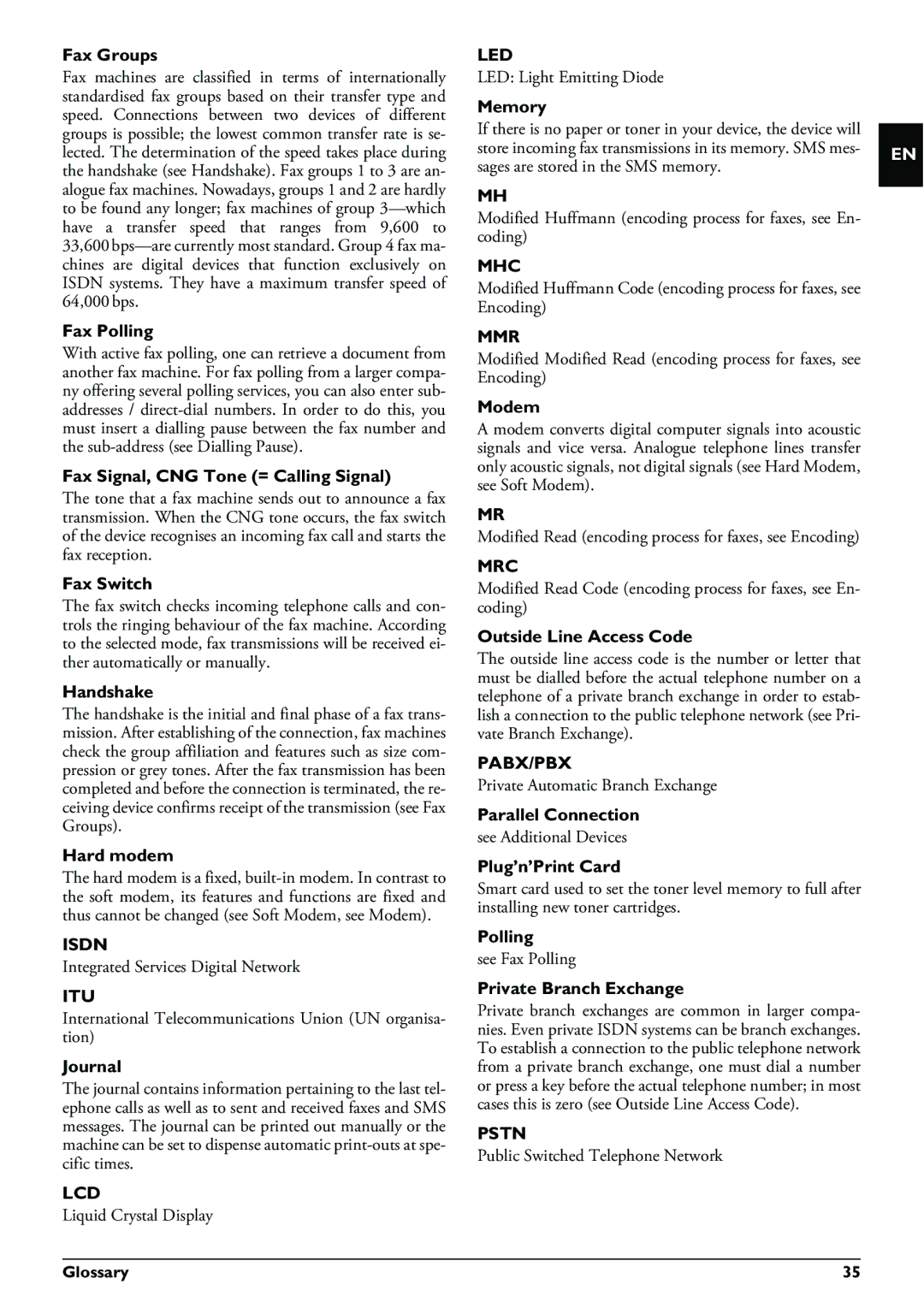
Fax Groups
Fax machines are classified in terms of internationally standardised fax groups based on their transfer type and speed. Connections between two devices of different groups is possible; the lowest common transfer rate is se- lected. The determination of the speed takes place during the handshake (see Handshake). Fax groups 1 to 3 are an- alogue fax machines. Nowadays, groups 1 and 2 are hardly to be found any longer; fax machines of group
Fax Polling
With active fax polling, one can retrieve a document from another fax machine. For fax polling from a larger compa- ny offering several polling services, you can also enter sub- addresses /
Fax Signal, CNG Tone (= Calling Signal)
The tone that a fax machine sends out to announce a fax transmission. When the CNG tone occurs, the fax switch of the device recognises an incoming fax call and starts the fax reception.
Fax Switch
The fax switch checks incoming telephone calls and con- trols the ringing behaviour of the fax machine. According to the selected mode, fax transmissions will be received ei- ther automatically or manually.
Handshake
The handshake is the initial and final phase of a fax trans- mission. After establishing of the connection, fax machines check the group affiliation and features such as size com- pression or grey tones. After the fax transmission has been completed and before the connection is terminated, the re- ceiving device confirms receipt of the transmission (see Fax Groups).
Hard modem
The hard modem is a fixed,
ISDN
Integrated Services Digital Network
ITU
International Telecommunications Union (UN organisa- tion)
Journal
The journal contains information pertaining to the last tel- ephone calls as well as to sent and received faxes and SMS messages. The journal can be printed out manually or the machine can be set to dispense automatic
LCD
Liquid Crystal Display
LED
LED: Light Emitting Diode
Memory
If there is no paper or toner in your device, the device will store incoming fax transmissions in its memory. SMS mes- sages are stored in the SMS memory.
MH
Modified Huffmann (encoding process for faxes, see En- coding)
MHC
Modified Huffmann Code (encoding process for faxes, see Encoding)
MMR
Modified Modified Read (encoding process for faxes, see Encoding)
Modem
A modem converts digital computer signals into acoustic signals and vice versa. Analogue telephone lines transfer only acoustic signals, not digital signals (see Hard Modem, see Soft Modem).
MR
Modified Read (encoding process for faxes, see Encoding)
MRC
Modified Read Code (encoding process for faxes, see En- coding)
Outside Line Access Code
The outside line access code is the number or letter that must be dialled before the actual telephone number on a telephone of a private branch exchange in order to estab- lish a connection to the public telephone network (see Pri- vate Branch Exchange).
PABX/PBX
Private Automatic Branch Exchange
Parallel Connection
see Additional Devices
Plug’n’Print Card
Smart card used to set the toner level memory to full after installing new toner cartridges.
Polling
see Fax Polling
Private Branch Exchange
Private branch exchanges are common in larger compa- nies. Even private ISDN systems can be branch exchanges. To establish a connection to the public telephone network from a private branch exchange, one must dial a number or press a key before the actual telephone number; in most cases this is zero (see Outside Line Access Code).
PSTN
Public Switched Telephone Network
EN
Glossary | 35 |
